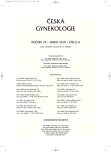DNA analysis on Y chromosomal AZF region deletions in Slovak population
Authors:
R. Behulová 1; Ľ. Strháková 2; I. Boroňová 3; I. Bernasovký 3; J. Bernasovská 3; M. Konečný 4; Vanda Repiská 1
Authors‘ workplace:
Ústav lekárskej biológie, genetiky a klinickej genetiky LF UK a FNsP, Bratislava, vedúci pracoviska doc. MUDr. D. Böhmer, PhD.
1; Medirex a. s, Oddelenie klinickej genetiky, Bratislava, vedúci lekár MUDr. P. Križan, CSc.
2; Prešovská univerzita v Prešove, Fakulta humanitných a prírodných vied, Prešov, prof. RNDr. I. Bernasovský, DrSc.
3; Onkologický ústav sv. Alžbety, s. r. o., Oddelenie klinickej genetiky, Bratislava, RNDr. M. Konečný Ph. D.
4
Published in:
Ceska Gynekol 2010; 75(4): 317-322
Overview
Objective:
Study on Y chromosomal AZF region deletions in Slovak population, application of DNA technique.
Design:
Genetic-prospective study.
Setting:
Institute of Medical Biology, Genetics and Clinical Genetics, Faculty of Medicine, Comenius University in Bratislava.
Methods:
For detecting microdeletions in the Y-chromosomal AZF region in men with fertility disorders and for identifying Y-specific sequences we used the method of polymerase chain reaction (PCR) with using three different sets of sY sequences. For a verification of the specific type of deletion we used also fluorescently labeled kit.
Results:
Diagnoses of referred patients were divided into 2 groups: azoospermia, oligospermia. In the followed-up group of 822 patients there were 349 patients with azoospermia, 473 patients with oligospermia. Globally we reported 38 cases of deletions in the AZF region of the Y chromosome, i.e. 4.62%. 24 patients with deletion are from the group of patients with azoospermia, i.e. 6.88%, 14 patients are from the group of patients with oligospermia (2.95%). Considering particular types of deletions we recorded deletions in each region, AZFa, AZFb and AZFc, combinated AZFbc deletion, but also a complete deletion of the whole AZF region.
Conclusion:
The study confirmed that detection of microdeletions of the AZF region is significant from diagnostic and prognostic view and it pointed out the importance of selection criteria for selecting patients.
Key words:
male infertility, Y chromosome, microdeletions.
Sources
1. Ferlin, A., Moro, E., Rossi, A., et al. The human Y chromosome’s azoospermia factor b (AZFb) region: sequence, structure, and deletion analysis in infertile men. J Med Genet 2003, 40, p.18-24.
2. Ferlin, A., Arredi, B., Speltra, E., et al. Molecular and Clinical Characterization of Y Chromosome Microdeletions in Infertile Men: A 10-Year Experience in Italy. J Clin Endocrinol Metab 2007, 92, p. 762-770.
3. Foresta, C., Garolla, A., Bartoloni, L., et al. Genetic abnormalities among severely oligospermic men who are candidates for intracytoplasmic sperm injection. J Clin Endocr Metab 2005, 90, p.152-156.
4. Gaillyová, R., Valášková, I., Beharka, R., a kol. Výsledky vyšetření mikrodelecí oblasti AZF(Yq) u mužů s reprodukčními problémy. Urol List 2007, 5(3), s.18-21.
5. Gatta, V., Stuppia, L., Calabrese, G., et al. A new case of Yq microdeletion transmitted from a normal father to two infertile sons. J Med Genet, 2002, 39, p. 27-28.
6. Havlovicova, M., Semanová, E. Genetické poradenství. Neonatal List 2004, 10, s.14-15.
7. Kamp, C., Huellen, K., Fernandes, S., et al. High deletion frequency of the complete AZFa sequence in men with Sertoli-cell-only syndrome. Molec Hum Reprod 2007, 1, p. 987-994.
8. Krausz, C., Forti, G., McElreavey, K. The Y chromosome and male fertility and infertility. Int J Androl 2003, 26, p. 70-75.
9. Macek, M., Vilímová, Š., Potužníková, P., a kol. Využití lékařské genetiky v reprodukční medicíně. Čas Lék Čes 2002, 141, s. 28-34.
10. Maurer, B., Gromoll, J., Simoni, M., Nieschlag. E. Prevalence of Y chromosome microdeletions in infertile men who consulted a tertiary care medical centre: the Munster experience. Andrologia 2001, 33, p. 27-33.
11. Pathak, D., Premi, S., Srivastava, J., et al. Genomic instability of the DYZ1 repeat in patients with Y chromosome anomalies and males exposed to natural backgroundradiation. DNA Res 2006, 13, p.103-109.
12. Simoni, S., Bakker, E., Krausz, C. EAA/EMQN best practice guidelines for molecular diagnosis of Y-chromosomal microdeletions. State of the art 2004. Int J Androl 2004, 27, p. 240-249.
13. Skaletsky, H., Kuroda-Kawaguchi, T., Minx, PJ., et al. The male - specific region of the human Y chromosome is a mosaic of discrete sequence classes. Nature 2003, 423, p. 825-837.
14. Thornhill, AR., Guenther, AJ., Barbarotto, GM., et al. False-positive Y microdeletion result for a fertile male caused by an alternation under a PCR primer. Int J Androl 2002, 25, p. 352-357.
15. Vogt, PH. AZF deletions and Y chromosomal haplogroups: history and updates on sequence. Hum Reprod 2005, 11, p.319-336.
16. Vogt, PH., Falcao, CL., Hanstein, R., Zimmer, J. AZF Proteins. Int J Androl 2008, 31, p. 383-394.
Labels
Paediatric gynaecology Gynaecology and obstetrics Reproduction medicineArticle was published in
Czech Gynaecology

2010 Issue 4
Most read in this issue
- Shoulder dystocia during vaginal delivery
- Repair of the 3rd and 4th degree obstetric perineal tear
- Perinatal brachial plexus palsy
- Complications of radical oncogynecological operations
